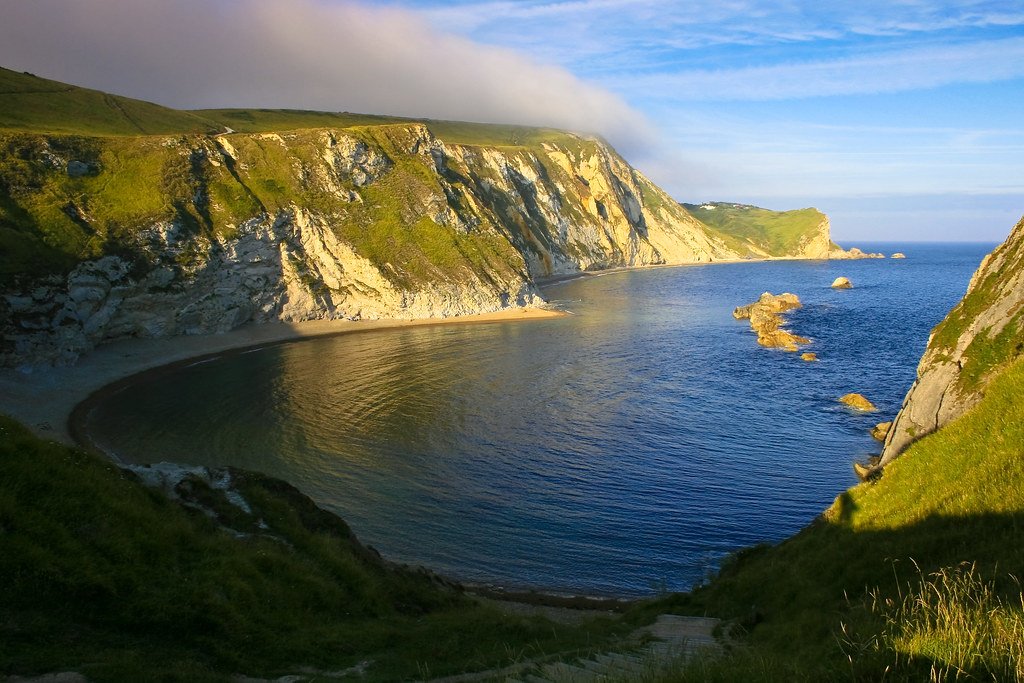Nestled along the southern coast of England, the Jurassic Coast is a treasure trove of prehistoric wonders. This stunning 95-mile stretch of cliffs is not just a feast for the eyes with its dramatic landscapes; it is a window into a world that existed millions of years ago. Imagine standing on the edge of these cliffs, knowing that beneath your feet lie secrets of creatures that roamed the earth long before humans. The Jurassic Coast continues to captivate scientists and enthusiasts alike, as it reveals new dinosaur discoveries to this day. But what makes this coastline so special? Why does it keep unveiling new secrets? Let’s delve into the heart of this ancient mystery.
The Geological Marvel of the Jurassic Coast

The Jurassic Coast is a geological wonder that spans three geological periods: the Triassic, Jurassic, and Cretaceous. Each layer of rock along the coast tells a story of a different era, much like the chapters of a thrilling novel. These layers were formed over 185 million years, capturing a timeline of life and evolution. The cliffs, with their vibrant hues of red, white, and gray, are not just beautiful; they are historical records waiting to be read. Erosion plays a crucial role here, as it gradually unveils fossils that have been hidden for millennia. It’s like nature’s own excavation site, slowly revealing its secrets to those who dare to explore.
Fossil Hunting on the Jurassic Coast
Fossil hunting along the Jurassic Coast is akin to a treasure hunt, where every rock could potentially hold a piece of history. Enthusiasts and scientists flock to this area, hoping to uncover remnants of the past. The beaches of Charmouth and Lyme Regis are particularly popular spots, where the tides often wash up ancient fossils. It’s not uncommon to find ammonites, belemnites, and even dinosaur bones scattered along the shore. For those with a keen eye and a bit of patience, the Jurassic Coast offers a chance to touch history with their own hands.
Recent Dinosaur Discoveries
Despite being explored for centuries, the Jurassic Coast continues to surprise with new dinosaur discoveries. Recently, a significant find was made by a local fossil hunter who stumbled upon a massive ichthyosaur skeleton. These marine reptiles, often referred to as “sea dragons,” once roamed the ancient seas that covered this land. Such discoveries are not just exciting; they provide valuable insights into the diversity of life during the Jurassic period. Each new find adds another piece to the puzzle of Earth’s prehistoric past.
The Role of Erosion in Unveiling Fossils
Erosion is both a destructive and creative force along the Jurassic Coast. While it gradually wears away the cliffs, it also reveals the fossils hidden within. Rain, wind, and waves constantly shape the landscape, causing rocks to crumble and exposing new layers beneath. This natural process is crucial for paleontologists, as it brings to light fossils that would otherwise remain buried. However, it also poses a challenge, as valuable specimens can be lost to the sea if not discovered in time. The balance between preservation and discovery is a delicate dance along this coastline.
Contributions of Local Fossil Hunters

Local fossil hunters play a vital role in uncovering the secrets of the Jurassic Coast. Armed with hammers and keen eyes, they scour the beaches and cliffs for hidden treasures. Many significant discoveries have been made by these dedicated individuals, who often work alongside professional paleontologists. Their enthusiasm and knowledge contribute greatly to our understanding of the area’s prehistoric past. The collaboration between amateurs and experts is a testament to the shared passion for uncovering the mysteries of the Earth.
Scientific Research and Exploration
The Jurassic Coast is not just a playground for fossil hunters; it is a hub of scientific research and exploration. Universities and research institutions conduct studies to understand the geological and paleontological significance of the area. Advanced technologies, such as 3D scanning and radiometric dating, are used to analyze fossils and determine their age. These studies help scientists piece together the history of life on Earth, providing insights into how ecosystems have evolved over millions of years. The Jurassic Coast is a living laboratory that continues to offer new opportunities for discovery.
The Impact of Climate and Environmental Changes

Climate and environmental changes have a profound impact on the Jurassic Coast. Rising sea levels and increased storm activity accelerate erosion, affecting the rate at which fossils are uncovered. While this can lead to more frequent discoveries, it also threatens the preservation of existing specimens. Conservation efforts are underway to protect this valuable heritage, balancing the need for scientific exploration with the preservation of natural beauty. The challenges posed by climate change highlight the importance of sustainable practices in managing this unique site.
Educational and Tourism Opportunities
The Jurassic Coast is not only a site of scientific interest but also a popular destination for tourists and educators. Guided fossil walks and educational programs offer visitors a chance to learn about the area’s rich history. Museums and visitor centers display some of the most significant finds, providing context and information about the region’s prehistoric past. Tourism plays a crucial role in supporting local communities, and efforts are made to promote responsible and sustainable tourism practices. The Jurassic Coast is a place where learning meets adventure, inspiring curiosity and wonder in visitors of all ages.
The Future of Discoveries on the Jurassic Coast

As the Jurassic Coast continues to evolve, so does the potential for new discoveries. The interplay between natural forces and human exploration ensures that this coastline will continue to reveal its secrets for years to come. Scientists and enthusiasts remain hopeful that more groundbreaking finds await, offering new insights into the history of our planet. The Jurassic Coast stands as a testament to the wonders of the natural world, inviting us to explore, learn, and appreciate the incredible history that lies beneath our feet. What new secrets will the cliffs reveal next? Only time will tell.



